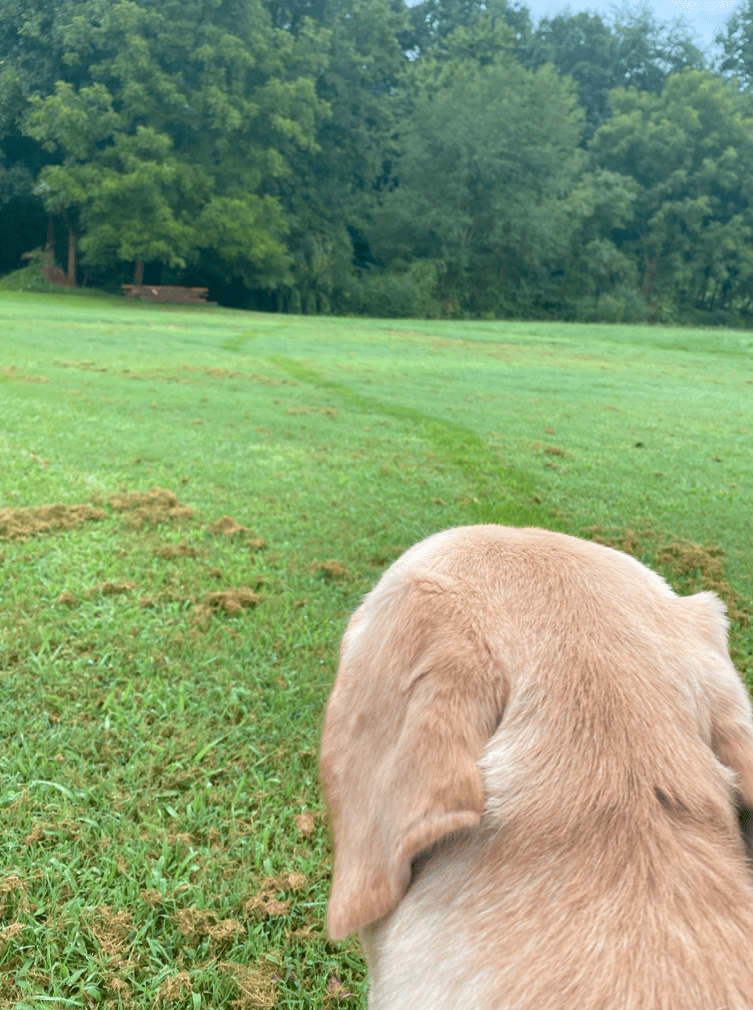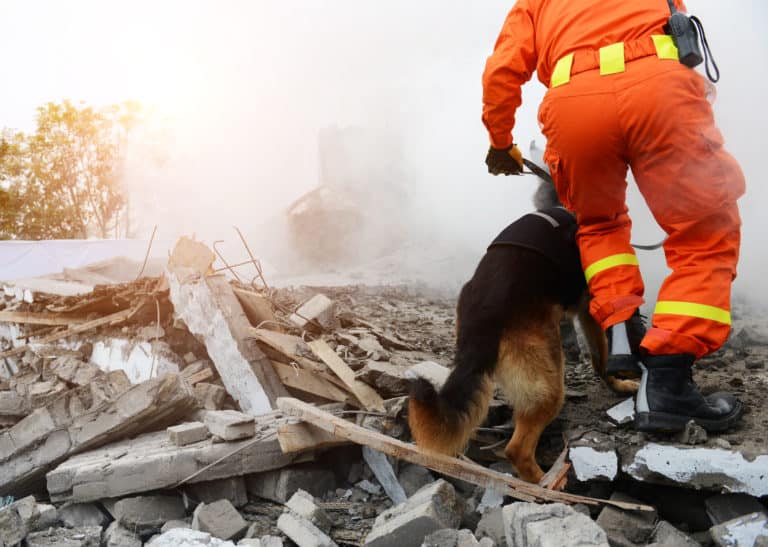Search and Rescue (SAR) units require dogs trained in a number of different disciplines in order to be able to effectively locate missing individuals in a variety of settings. Not only do SAR dogs need to be able to locate both living and deceased individuals, they must also be trained to work well in the terrain and environmental conditions in which their unit operates.
SAR work is not as straightforward as a dog simply possessing the capability of finding lost people. Years of training are often required to create an effective SAR K9-handler team, and each team must be certified in their respective discipline by a state or nationally recognized organization prior to deploying. Since the training and certification process is often lengthy and requires a significant amount of consistent effort, most SAR dogs deploy with one primary function. In the case of a SAR dog, it most likely would be certified in one type of search. However, there are exceptions where a dog can be cross trained in multiple search types such as with a Human Remains Detection dog where they are able to search a combination of land, water, and urban environments.
There are several types of Search and Rescue dogs, which all use a distinctive method to search for missing people. Each of these dogs is useful in certain circumstances or environments, and has a very special role to play in a SAR unit.
What are the search dog disciplines?
There are various disciplines which SAR units can choose to train their search K9 in. Each of these disciplines serves a purpose in a specific environment to accomplish the overall objective of the search. There are situations where multiple types of SAR dogs may be used and not be used in others. Additionally, there are variations to these disciplines depending on where they are trained and the requirements for the handler/unit in need of the dog.
Area Search Dog
These dogs are often referred to as the generalized term of Search and Rescue Dogs and can also be known as wilderness air scenting dogs, disaster search dogs, etc. A dog trained in area search is a live find discipline requiring a search dog to work off-lead at a distance from their handler. These dogs are searching for live human scent cones. Area search dogs are usually searching for any live human odor present within a given area. One typical example of where area search dogs are used is in wilderness search when an individual, presumed to be alive, has gone missing in a large, uninhabited area where they will be unlikely to run into irrelevant people. Examples of the areas where a wilderness search dog may work are national parks, rural woods and fields and mountains. There are other types of these dogs and where they are used, which we will discuss later on.
Tracking and Trailing Dog
Tracking dogs are more commonly utilized in Police K9 units and dog sports when searching for a subject with a fresh scent who was not presumed to travel far. These dogs are trained to meticulously follow a human’s path travelled exclusively through odor available on the ground. This odor typically consists of trapped skin grafts and primary odor which travelled through one’s shoe combined with the odor of crushed vegetation. Tracking dogs are not typically used in SAR units because they tend to work more slowly and do not often travel very long distances like a trailing dog would. A dog trained in trailing is used to follow one specific live human scent from point A to point B while ignoring all irrelevant human scents and distractor odors.
Trailing dogs usually start by picking up a human scent from the last place that a person was likely seen. Handlers will typically try to find a location that is not contaminated by the smells of irrelevant people. This helps increase the chances that a dog is searching for the correct person, and not following someone else’s scent. Trailing dogs are typically deployed in more densely populated environments, like when someone is believed to have left from their vehicle or home and travelled through areas where other people will be present. Typically, when a trailing dog is deployed, an exact target and search location are known. Trailing dogs use a combination of air scenting and tracking to locate their target.
Human Remains Detection (HRD) Dog
Human remains detection dogs, also known as cadaver dogs, are trained to locate deceased subjects or human remains in any quantity through the detection of odor from decomposition. HRD dogs may be deployed in a large number of environments. These dogs can be trained for land, urban areas, or water environments. HRD dogs who are trained on water are able to locate decomposing human tissue under the water from a moving boat. Usually, HRD dogs are trained to navigate the environments where they will primarily be expected to work, since different search strategies are often necessary for varying environments and climates. HRD dogs typically work off-lead at a distance from their handler and are taught an “indication,” also known as a trained final response (TFR), like other forms of detection dogs. As we discussed earlier, HRD dogs can be trained in one environment or can be cross trained to search in two or three. This, however, can take an extremely long time to train and certify across two or three environments.

Specific search dog specializations
Within the various search dog disciplines, there are also specializations which units and their handlers can train their K9 to work in. Some of these specialties require specific certifications, while others are specific to work conducted in a very particular type of environment.
Disaster Search Dog (DSD)
Disaster search dogs, also known as urban SAR dogs, are probably the most well-known of the search dog specializations. These dogs can be trained in either a form of live find area search using air scenting or looking for deceased victims through human remains detection. DSDs are deployed after natural disasters, acts of terrorism or building collapses to locate victims buried underneath the rubble. In the United States, the Federal Emergency Management Agency (FEMA) is the organization responsible for deploying these specially trained dog-handler teams. FEMA SAR units require a significant amount of training and have some of the most stringent requirements of any type of search and rescue work pursued in the United States.
Avalanche SAR
Avalanche SAR is a search specialization primarily required in mountainous regions with harsh winters. A very unique and physically demanding discipline, avalanche dogs are required to locate individuals trapped under the snow after an avalanche occurs. Avalanche dogs are also referred to as “ski patrol” dogs, and they are often the fastest, most efficient and reliable method of locating buried individuals after an avalanche. These dogs again are using the area search to locate potential trapped victims.
Wilderness SAR
Wilderness SAR dogs are deployed in areas such as national parks, mountains, woods and extremely rural areas where a dog is required to search a significant amount of area. Oftentimes, wilderness search dogs must navigate difficult terrain and physical barriers such as dense foliage when working. Like urban and avalanche dogs, wilderness SAR dogs search for live human scent cones.
Water HRD
Water HRD dogs are specially trained to locate deceased individuals or human remains located underneath bodies of waters such as rivers or lake. Water HRD dogs travel on a boat with their handler in a search pattern which should allow them to move into any scent clouds being emitted by target odor below the surface. Water HRD dogs are certified independently of their general HRD certification, and the training process and expectations for water HRD dogs is different than it would be for land HRD dogs.
In summary
Search and rescue dogs are incredible animals trained to save lives and bring closure to families. Search dog training is complex and time intensive, but is one of the most rewarding directions that a handler can choose to pursue with their dog. There are many different search dog disciplines to choose from and even various specializations that can be pursued. All are equally as important as the next, and require strong dedication and time to complete the necessary training and certification.
If you are interested in exploring options for Search and Rescue K9 training, reach out via email at dogtraining@blackhillsk9.com. We always enjoy talking with current and potential handlers about their passion for this important role in a SAR unit. Remember, one of the best things you can work on with a potential SAR dog is environmental stability, and conditioning it for situations it will be working in.
In our next blog, we will be discussing specifically the work of HRD dogs (also known as cadaver dogs); the vital role they play in bringing closure to families; and the environment the K9-handler team works in.


